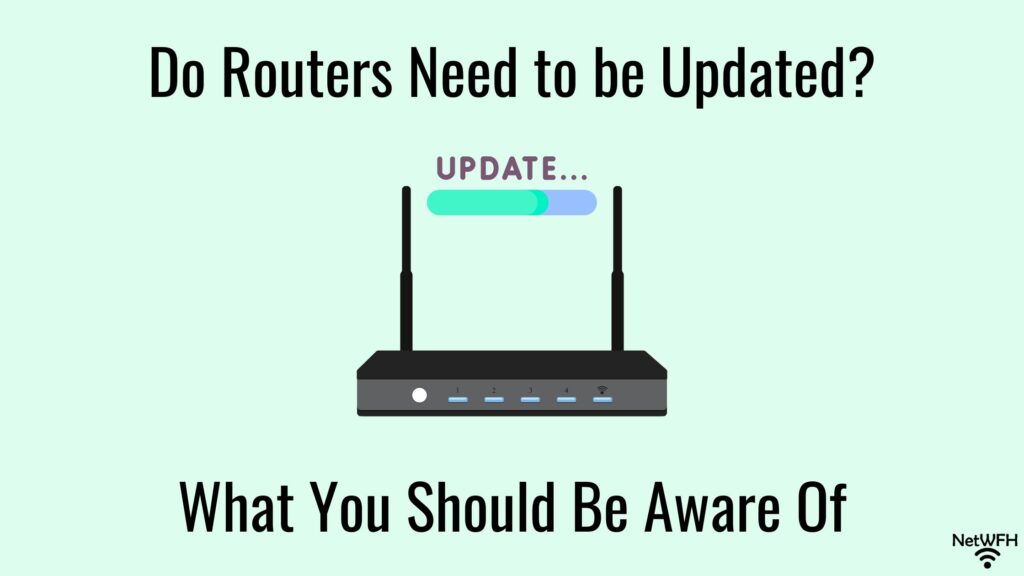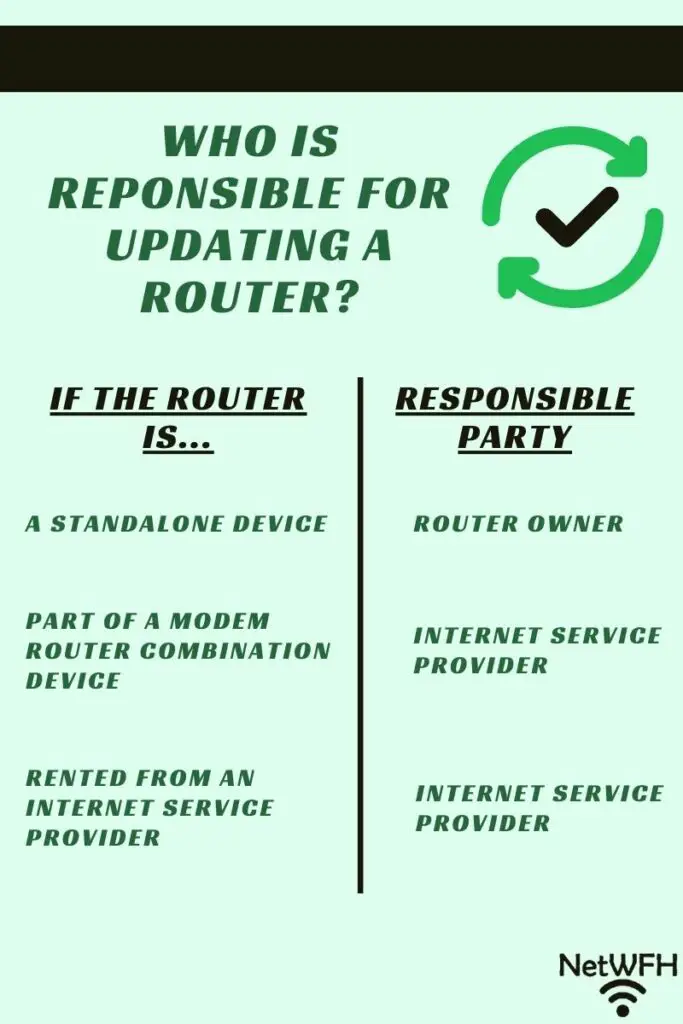This post contains affiliate links.

In this day and age, it’s common to have to update our home network devices when new software is developed for them.
To name a few, the devices that require updates include your:
- Computer
- Smart phone
- Gaming system
- Smart TV
All of these devices are similar in that they’re run by software located on the device.
In this sense, your router is not unlike all of these devices in your home network. Routers also have software that tell them how to operate, just like the other smart devices in your home.
With that said, does your router need to be updated like the rest of the devices in your home network? Or can you forget about your router once it’s set up?
Routers need to be updated on a periodic basis. When security vulnerabilities or operating efficiencies are identified by a router manufacturer, firmware updates are developed and issued. These firmware updates must be installed on the router in order to provide benefit to the device.
In this post, I’ll talk about what’s involved when it comes to updating your router. I’ll also talk about who is responsible for updating your router.
Let’s get started.
Routers Need to Be Updated
Yes, it’s true.
Your router needs to be updated.
You shouldn’t be too upset about this, however. Updating your router actually protects you (and the device) in the long run.
Before we get too far into that, let’s talk about why routers need updates in the first place.
This all has to do with how routers operate.
Routers are run by software. This software is embedded on computer chips that are located inside the device. Another term for this software is “firmware”.
When a router is purchased, it comes loaded with the original firmware that the router manufacturer created when the device was released to the public for purchase.
After a new router is released for purchase, customers expect the router to last for years.
Think about it.
When you bought your router, were you expecting to buy another one any time soon?
I didn’t think so.
During these years that a given router is in operation, quite a bit can change in the environment around it.
There are two main areas we should look at here.
Routers Need to Be Updated to Provide Security Enhancements
Security is the most important reason for router updates.
In today’s day and age, cybersecurity threats are ever-evolving. According to Packetlabs, there were an estimated 2,200 cybersecurity attacks every day in 2022.
What does this statistic tell you?
First and foremost, it tells you that cybersecurity threats are evolving every day. The cybersecurity threats we were faced with two years ago aren’t the same ones we face today.
This is relevant to routers because router software is created to address the cybersecurity threats that were common at the time the router was first developed. Not the cybersecurity threats the router will face a few years down the road.
In short, routers are faced with new cybersecurity threats each year, and they need to be updated to address the new threats that arise while they’re in operation.
As a result, router manufacturers need to update the software for their routers to address the latest and greatest cyber attacks.
When it’s identified that a router has a potentially vulnerability to a new cyber attack, the router manufacturer updates the router’s code. These software updates protect the router (and your network) from these vulnerabilities.
Routers Need Updates to Improve Their Functionality
The other main reason routers need updates is to ensure they continue to operate smoothly once a customer buys the device.
Similar to the cybersecurity threats I detailed in the section above, advancements in technology are happening just as quickly.
Once a router is released for sale to the public, a lot can change in the years that follow.
For example, software bugs could be found in the router firmware after the router is already on the shelves.
What’s the best way to fix the bugs?
Issue a software update.
Also, the router manufacturer could develop new features for the router that improve its performance.
What’s the best way to get those feature enhancements into their products?
By issuing a software update.
As you hopefully have noticed by now, firmware updates are the way that router manufacturers can ensure their products run smoothly after they’re released to the public.
As I detailed above, most of these firmware upgrades are for functionality improvements and security reasons. For evidence of this, look no further than the notes about the latest firmware update for my router:

As you can see, the latest firmware update for my router was issued for exactly these reasons.
Who Is Responsible for Updating My Router?
Ok, so we’ve established your router needs to be updated.
The next question is, who’s responsible for updating your router?
That all depends upon your situation.

Who Is Responsible for Updating a User Owned Standalone Router?
For example, if you own your own standalone router, you’re responsible for updating the device.
To be clear, I’m talking about routers that are separate devices from the modem in a home network.
Before you get overwhelmed by this responsibility, I should say that updating your router is extremely easy.
For a breakdown of how to update your router’s firmware, I’ve detailed these steps in an article I’ve previously written that you might want to check out.
Ok, so if you own your own standalone router you’re responsible for updating it.
Are there any other scenarios you need to consider when it comes to router updates?
You bet there are.
Who Is Responsible for Updating a Rented Router?
If you rent your router from your internet service provider (ISP), you’ll be off the hook for updating it. Most ISPs will automatically push software updates to the devices that you rent from them.
After all, when you rent a router from an ISP, your ISP doesn’t allow you to make changes to the router’s settings. As a result, they have to update the device simply because you aren’t able to.
Who Is Responsible for Updating a Modem Router Combination Device?
This same principle applies if you bought a modem and router combination device.
If you’re not familiar with modem and router combo devices, hold up a second. I’ve written another post that covers modem and router combination devices that’ll help you understand what I’m referencing here.
Ok, back to the topic at hand.
If you have a modem and router combination device, your ISP will automatically provide firmware updates to your device.
These updates happen without you having to do anything. When your router’s manufacturer publishes a new version of firmware, your ISP will send it to your device over the internet to update it.
Although this might sound nice at first, I’ve seen reviews for modem and router combo devices that have had bad experiences with their ISP updating their device. On occasion, your ISP might push a bad update to your device, or the update might fail during installation.
This is just something to keep in mind if you’re in the market for a new router. Sometimes it’s nice to be in control of your own updates.
How Do I Know if My Router Needs to Be Updated?
If you own your own router and you’re responsible for updating it, it can be difficult to tell when there’s an update is available for it.
On occasion, you may be able to tell based upon your router’s performance.
If you notice your internet performance starting to drag, your router might need an update. This might also be the case if your internet connection starts to become inconsistent and you haven’t updated your router in a while.
These situations might give you an idea of when your router needs a performance update.
The troubling thing is, if your router has a security update available, you won’t know it based upon how the router is functioning. That’s because a lot of security updates have little effect on how the router operates on a daily basis.
With this in mind, it’s best practice to periodically check to see if your router has any updates available for it.
Every four months or so, log in to your router’s settings and see if there’s an update available for it.
It only takes a minute to do this, and your certainly won’t regret it.
After all, router updates can only make your device work better and operate more safely.
Wrap Up
At this point, it should be crystal clear that your router has to be updated. You should also have a good understanding of who is responsible for updating your router.
If you have any questions about the above information, please leave a comment below.
If you found this information useful, here are some other posts I’ve written on similar topics that might interest you:
How to Update Your Router: The Ultimate Guide
What Does a Router Look Like? How to Identify Your Device

